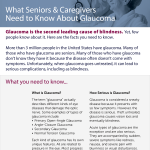January is National Glaucoma Awareness Month, an important health campaign informing us that 3 million Americans have glaucoma and that it is one of the leading causes of irreversible blindness. Those facts are scary in and of themselves, but what’s more concerning is that half of those who have glaucoma are completely unaware of it. The Glaucoma Research Foundation calls it “the sneak thief of sight” since there are few or vague symptoms. As much as 40% of vision can be lost without a person noticing, says the GRF.
What is Glaucoma?
For those who don’t know, glaucoma is a group of related eye disorders that cause damage to the optic nerve (the optic nerve carries information from the eye to the brain).
There are two main types of glaucoma – open-angle glaucom, and angle closure glaucoma.
Open-angle glaucoma is by far the most common form of glaucoma, accounting for 90% of cases. Open-angle glaucoma is a direct result of slow clogging drainage canals which increase eye pressure. As long as the pressure persists, the optic nerve is coincidentally damaged. Not only is open-angle life-long and chronic – it is initially undetectable. Many people don’t experience any symptoms in the early stages of the disease, therefore they fail to notice their vision slowly declining. The problem with this is that any vision loss experienced is permanent.
Angle-closure glaucoma, also referred to as acute glaucoma or narrow-angle glaucoma, occurs when the angle between the iris and the cornea closes (as opposed to narrowing), causing the drainage canals to becomes blocked. In contrast with open-angle glaucoma, angle closure glaucoma develops rapidly. With this type, you DO experience symptoms and the damage is usually noticeable.
Are You at Risk?
Below are some of the risk factors associated with glaucoma. Click HERE for “Glaucoma: A Guide for Seniors,” provided by Aging.com.
Age
Those 60 years over are six times more likely to develop glaucoma than those who are in younger age groups.
[Tweet “Adults 60 years and older are 6x more likely to develop glaucoma. #NationalGlaucomaAwarenessMonth”]
Race
African Americans and Hispanics are at a greater risk of developing glaucoma than other races.
[Tweet “African Americans & Hispanics are at greater risk of developing glaucoma. #NationalGlaucomaAwarenessMonth”]
Family History
You are 4 – 9 times more likely to develop glaucoma if an immediate relative has glaucoma.
[Tweet “If your a family member has glaucoma, you are 4-9x more likely to get it.”]
Medical Conditions
Heart disease, diabetes, high blood pressure, current or previous eye injuries, and prolonged use of oral steroids or cortisone treatments increase your risk of developing glaucoma.
[Tweet “Certain medical conditions can increase your risk for glaucoma.”]
How Caregivers Can Help Seniors With Glaucoma
One of the most common concerns for people diagnosed with glaucoma is blindness. This concern is completely valid because glaucoma can lead to vision loss and in extreme cases, blindness. The good news is that it can be prevented with proper and consistent treatment. Here are a few ways caregivers can help seniors with glaucoma (especially for those with impaired vision).
Caregivers can ensure the home is always well-lit.
Caregivers can help ensure the home is adequately lit at all times. This is important for a few reasons. First of all, poor lighting can lead to eye strain for people who have difficulty seeing, which in turn can cause headaches. Second, dim lighting increases the chances of having an accident, including falls. This is a huge concern because senior falls can be detrimental and lead to further complications.
Caregivers can help around the house.
Caregivers can be highly useful for tasks that may be difficult for those with impaired vision. This includes finding items, helping prepare meals, and grabbing items in hard to reach places.
Caregivers can remind you to be consistent with glaucoma medications.
Caregivers can be extremely helpful when it comes to reminding you to take glaucoma medications properly and at regular intervals. Eyedrops are one of the most common treatments used to lower eye pressure in those with glaucoma. Unfortunately, many people don’t administer them properly or use them frequently enough. As a result, the medications are far less effective and can cause spikes in eye pressure. This can cause optic nerve damage and vision loss.
Caregivers can help seniors make and keep eye appointments.
One of the best things seniors can do to protect their eyesight is to get regular eye exams. Caregivers can help seniors by encouraging them to get their eyes checked regularly and by helping them make and keep their appointments. Caregivers can also help seniors get to their eye appointments by driving them.
On the bright side…
Even though glaucoma is incurable, it is completely treatable, meaning the disease can be managed. Taking the initiative to get regular eye exams and staying consistent with your treatment is the best way to preserve your vision.
The only way to predict if there’s a cloud on your horizon due to glaucoma is to get tested. No matter what the diagnosis, the forecast is for clear vision in the years ahead.
—Willard Scott, former Today Show weather presenter and longtime aging advocate
Download: What Seniors and Caregivers Need to Know About Glaucoma
“What Seniors and Caregivers Need to Know About Glaucoma,” written by Ashley LeVine and updated by Michelle Flores, Amada Blog contributors. Photo by mari lezhava on Unsplash.
The post What Seniors and Caregivers Should Know About Glaucoma appeared first on Amada Senior Care.
from Amada Senior Care https://ift.tt/3suIx5m
via IFTTT

Comments
Post a Comment